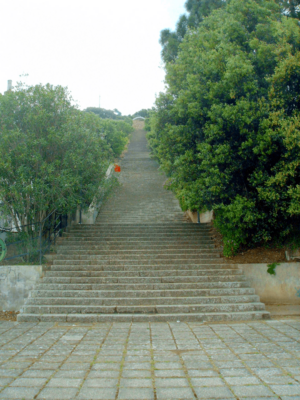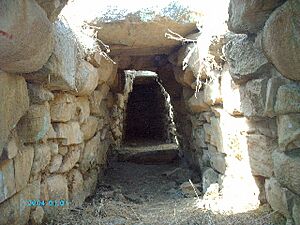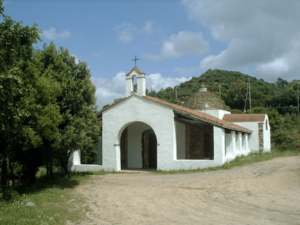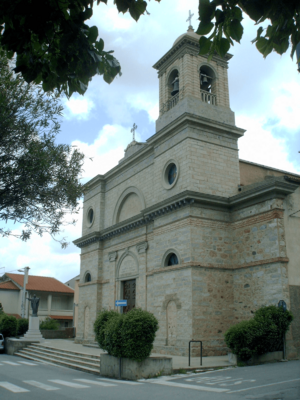Gonnosfanadiga facts for kids
Quick facts for kids
Gonnosfanadiga
Gonnos
|
||
|---|---|---|
| Comune di Gonnosfanadiga | ||
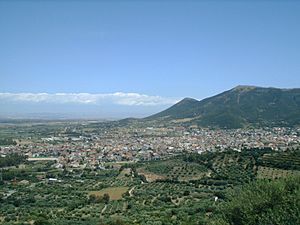 |
||
|
||
| Country | Italy | |
| Region | Sardinia | |
| Province | South Sardinia | |
| Frazioni | Pardu Atzei | |
| Area | ||
| • Total | 125.23 km2 (48.35 sq mi) | |
| Elevation | 185 m (607 ft) | |
| Population
(December 31, 2015)
|
||
| • Total | 6,634 | |
| • Density | 52.975/km2 (137.203/sq mi) | |
| Demonym(s) | Gonnesi | |
| Time zone | UTC+1 (CET) | |
| • Summer (DST) | UTC+2 (CEST) | |
| Postal code |
09035
|
|
| Dialing code | 070 | |
| Patron saint | Santa Barbara | |
| Saint day | December 4 | |
Gonnosfanadiga (also called Gonnos or Gonnos-Fanàdiga in Sardinian language) is a town in Sardinia, Italy. It is part of the province of South Sardinia. The town is located between the flat Medio Campidano area and the Monte Linas mountains.
Most people in Gonnosfanadiga work in farming. They grow olives, make olive oil, and produce bread, sweets, and pig meat. They also raise animals. This area is special because it has two ancient giants' graves.
Contents
Exploring Gonnosfanadiga's Landscape
Gonnosfanadiga's land is split into three main parts. There is the flat plain of Medio Campidano to the northeast. Then there are hills around the town. Finally, there are the Monte Linas mountains to the southwest. A small village called Pardu Atzei is also part of its territory.
Mountains and Rivers
The mountains and hills here are full of minerals. They are mostly made of granite and schist rock. The highest point is Punta de sa Perda Mesa, which is about 1,236 meters (4,055 feet) high.
The town itself sits on the side of these mountains. The Rio Piras river flows through it. This river can sometimes flow very fast, like a torrent.
A Journey Through Time: Gonnosfanadiga's History
People have lived in the Gonnosfanadiga area for a very long time. Studies show that early settlements began around 6,000 to 4,000 BC. This was during the early Neolithic period. The area was a good place to live because it had many resources.
Ancient Times
There are also important signs from the Nuragic period. These include ancient stone towers called Nuraghes and giants' graves. One of these, the San Cosimo tomb, is one of the largest in Sardinia. It was discovered in the early 1980s.
The Phoenicians were skilled sailors from the Middle East. They founded a colony nearby. While we are not sure if they lived exactly in Gonnosfanadiga, the area was close to their trading routes.
Around 200 BC, the Romans arrived in Sardinia. Many Roman items have been found here. These include coins, jewelry, and weapons. Remains of Roman forts, camps, and cemeteries have also been found.
Medieval Period and Beyond
Around 600 AD, Byzantine monks came to the island. They helped spread Christianity. You can still see signs of their influence in place names and old churches. The rural church of S. Severa is a great example.
During the Middle Ages, several villages existed in the Gonnosfanadiga area. These included Bidda Atzei, Gonnos Fanadiga, and Aqua de Gonnos. They were part of the Judges of Arborea, an ancient Sardinian kingdom.
The modern town of Gonnosfanadiga has existed for centuries. During Spanish rule in Sardinia (around 1479-1650), documents describe life in the town. At this time, it belonged to the Marquis of Quirra.
On February 17, 1943, during World War II, the town faced a difficult event. It was bombed, and many civilians were hurt or killed. This event left a lasting impact on the people of Gonnosfanadiga.
Places to See and Explore
Gonnosfanadiga has interesting places to visit, from old buildings to ancient sites and beautiful nature.
Civil Architecture
The Gradinata (Flight of Steps)
The Gradinata is a famous flight of steps in Gonnosfanadiga. It is a notable feature of the town's design.
Public Wells
There are about 50 public wells in Gonnosfanadiga today. In the past, there were even more. These wells were very important for getting water for the town. They were also key meeting spots for people from different neighborhoods. Many streets and areas are still named after the wells that used to be there.
Today, the wells are not used for water or as much for social gatherings. However, they are still important landmarks for the people of Gonnosfanadiga. They offer a glimpse into the town's history and architecture.
Archaeological Sites
Giants' Grave of San Cosimo
The tomb of San Cosimo I is also known as Sa Grutta de Santu Giuanni. This ancient stone structure dates back to around 1500 BC. Its front has a large semicircular shape, about 26 meters (85 feet) wide. This leads to the burial chamber, which is about 20 meters (66 feet) long. This makes it one of the largest tombs in Sardinia.
The area around the tomb has many remains of Nuragic settlements. During digs in 1981, archaeologists found pottery, bowls, and jars. They also found a unique necklace made of glass. The site was also used during Roman times. You can easily reach this site from the main road between Gonnosfanadiga and Arbus.
Religious Architecture
Gonnosfanadiga is home to several churches:
- Church of Santa Barbara
- Church of Sacro Cuore (Sacred Heart)
- Church of Beata Vergine di Lourdes
Church of Santa Severa
The Church of Santa Severa is on a hill close to town. It dates back to the early Christian period (4th-5th century). It was built on an old Roman cemetery. This suggests that people have honored this saint here for a very long time. The church has been restored many times since 1797.
The building has a Latin cross shape. The main part of the church is about 10 by 4.2 meters (33 by 14 feet). It has a unique vaulted ceiling.
Disappeared Churches
Many other churches once stood in the area. The church of Sant'Antonio Abate was the first main church in the medieval village of Gonnos de Montanya. It was replaced by the Church of Santa Barbara.
The ruins of the parish church of San Pietro can still be seen in the Serru area. Another church, San Lorenzo, was about 4.10 by 10.45 meters (13.5 by 34.3 feet) long. The very old church of Sant'Elijah was active until 1903 but collapsed in 1908.
Other churches that once existed include Santa Mary of Montserrat, Santa Maria Itria, and Santa Elena. Some were even taken down to prevent them from becoming hideouts. There were also churches dedicated to San John, San Bartholomew, San Luke, San Anastasia, San Simeon, and San Michele.
Natural Areas
Park Perd'e Pibara
The Park Perd'e Pibara is south of Gonnosfanadiga. Most of it is covered by a thick, old forest of oak trees. You can also find other Mediterranean plants like filirea, arbutus, and heather.
In other parts of the park, you will see cistus, everlasting helichrysum, thyme, and broom. There is also a large area with mixed trees like cork oaks and pine trees.
This park is a great place for finding different kinds of mushrooms. It is also home to many animals. You might see wild boars, foxes, rabbits, goats, and hedgehogs. Many birds of prey, jays, and partridges live here too. There are also small rodents, reptiles, and large goldfish in a deep pond fed by spring water.
Inside the park, you can find an abandoned molybdenite mine. This is an interesting example of old industrial sites. The park is easy to get to and has many rest stops with benches and tables. Some of the old mine buildings have been fixed up. They are now used for meetings, exhibitions, and events about nature, hiking, and sports.
Mining History
Mining was once a very important job in this area, from ancient times until the 1970s. Large-scale mining started in the late 1800s and mid-1900s. It was well-organized and brought a lot of money to the community. However, mining has now completely stopped.
The following mines in Gonnosfanadiga are no longer in use:
- Mine Fenugu Sibiri
- Mine Loss' and Pibera
- Mine S'Acqua Prunas - Genna S'Olioni
- Mine Salaponi
Culture and Events
Events
Feast of Olives
The Feast of Olives, Agribusiness, and Local Crafts is a big event in Gonnosfanadiga. It is a chance for the town to show off its best local products. Gonnosfanadiga is also part of the National Association of Oil Cities.
This festival happens at the end of November, during the olive oil season. It brings together local farmers, artisans, and traders. Since the mid-1980s, many tourists who love good food, history, and nature have visited this festival. Besides the food, there are activities to help visitors learn about the town's culture and land.
During the event, you can watch how extra virgin olive oil is made at the mill. There are also exhibitions and historical displays about Gonnosfanadiga and its activities.
Economy: How Gonnosfanadiga Makes a Living
The economy of Gonnosfanadiga mainly relies on farming and animal raising. Many small, often family-run, businesses process farm products.
Main Products
The town is famous for its olive oil and table olives. The local olive type, called "Black of Gonnos," is known for its high quality. Other important products include traditional bread, handmade sweets, and meat from sheep, goats, and pigs. Honey and high-quality fruits and vegetables are also produced here.
Many people in Gonnosfanadiga sell these products. There are several butchers and many shops selling fruits, vegetables, milk, and dairy products.
Other Industries
There is some flower production and forestry, including cork and wood. Textile production is also limited.
Many residents work in services and industries in nearby areas. This is because there are not many large industries in Gonnosfanadiga itself. However, the town is now focusing more on tourism. This could help the local economy, which has faced challenges. These challenges include food crises and the closure of the mines. The industrial center of Villacidro, where many people used to work, has also faced difficulties.
Local crafts are also important, even if they are often hobbies. People work with wood, cork, and pottery. They also make traditional fabrics. However, the most famous craft is knife-making. Master knife makers have worked in Gonnosfanadiga for centuries. Their beautiful knives are often shown and recognized around the world.
See also
 In Spanish: Gonnosfanadiga para niños
In Spanish: Gonnosfanadiga para niños



